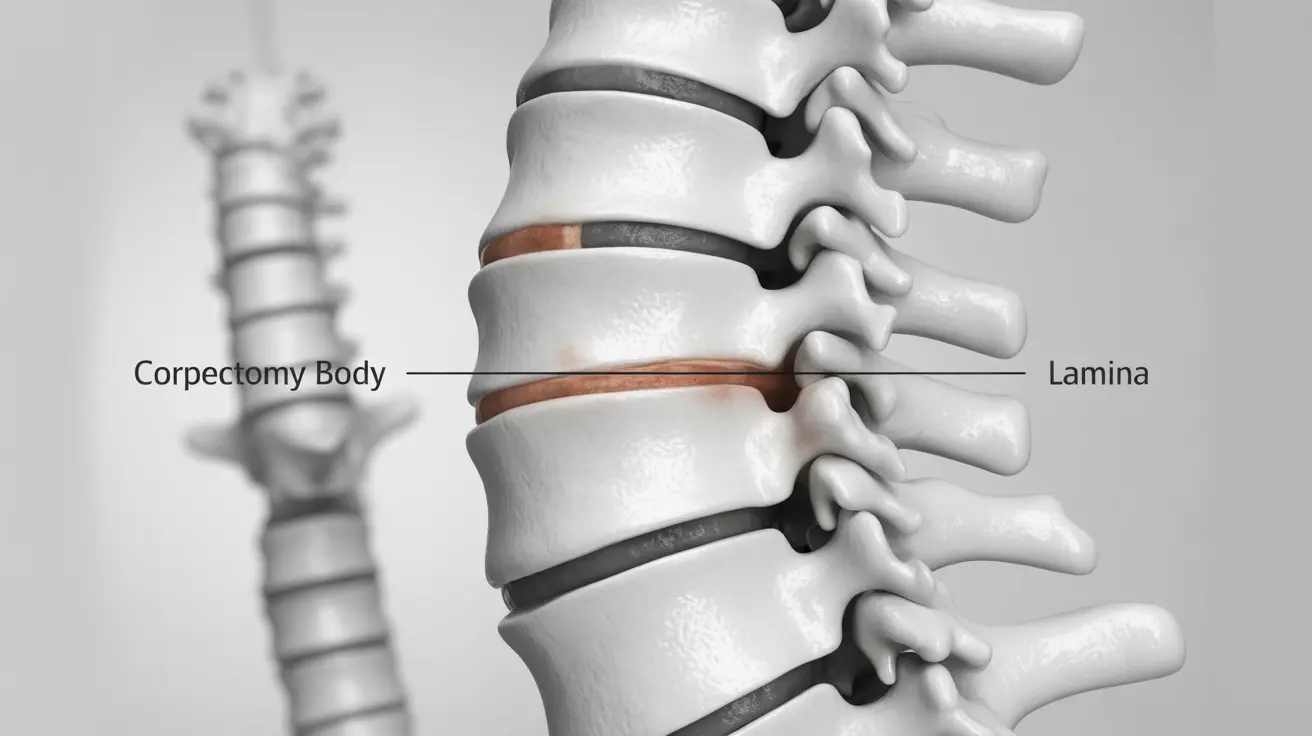When dealing with serious spinal conditions, surgical intervention may become necessary to relieve pressure on the spinal cord or nerve roots. Two common surgical procedures—corpectomy and laminectomy—offer different approaches to addressing spinal compression. Understanding the distinctions between these procedures can help patients have more informed discussions with their healthcare providers about their treatment options.
This comprehensive guide explores the key differences between corpectomy and laminectomy, including their purposes, surgical approaches, and expected outcomes. We'll examine how surgeons choose between these procedures and what patients can expect during recovery.
Understanding Corpectomy and Laminectomy: Basic Definitions
A corpectomy involves removing one or more vertebral bodies and adjacent discs to relieve pressure on the spinal cord. This procedure is typically performed from the front (anterior) of the spine and often requires spinal fusion to maintain stability.
In contrast, a laminectomy involves removing the lamina—the back portion of the vertebra that covers the spinal canal. This procedure is performed from the back (posterior) of the spine and may or may not require fusion, depending on the extent of the removal and the patient's specific condition.
Surgical Approaches and Techniques
Corpectomy Procedure
During a corpectomy, the surgeon:
- Makes an incision in the front or side of the neck (for cervical spine) or through the chest or abdomen (for thoracic/lumbar spine)
- Removes the vertebral body and adjacent discs
- Places a bone graft or cage to maintain proper spine height
- Stabilizes the area with plates and screws
Laminectomy Procedure
A laminectomy involves:
- Creating an incision in the back over the affected area
- Removing the lamina to create more space in the spinal canal
- Addressing any bone spurs or herniated disc material
- Potentially performing a fusion if needed for stability
Medical Conditions and Treatment Selection
The choice between corpectomy and laminectomy often depends on the specific condition being treated and its location in the spine. Corpectomy is typically preferred for:
- Severe cervical spinal stenosis affecting multiple levels
- Vertebral body tumors
- Severe compression from bone spurs or disc herniation
- Spinal cord compression from the front
Laminectomy is more commonly chosen for:
- Lumbar spinal stenosis
- Posterior nerve root compression
- Herniated discs causing nerve root compression
- Some cases of degenerative disc disease
Recovery and Rehabilitation Considerations
Recovery from a corpectomy generally requires more time and intensive rehabilitation compared to a laminectomy. Corpectomy patients typically stay in the hospital for 3-5 days and may need several months for full recovery. Laminectomy patients often have shorter hospital stays (1-3 days) and may return to light activities within a few weeks.
Frequently Asked Questions
What is the difference between corpectomy and laminectomy spinal surgeries? Corpectomy involves removing vertebral bodies and discs from the front of the spine, while laminectomy removes the lamina from the back of the spine. Corpectomy typically requires fusion, while laminectomy may not.
How do doctors decide whether to perform a corpectomy or a laminectomy? The decision depends on the location of spinal compression, number of levels affected, and specific condition being treated. Anterior compression often requires corpectomy, while posterior compression typically calls for laminectomy.
What conditions are treated by corpectomy versus laminectomy? Corpectomy typically treats severe cervical stenosis, vertebral tumors, and anterior spinal cord compression. Laminectomy addresses lumbar stenosis, posterior nerve compression, and certain types of herniated discs.
What are the risks and recovery times for corpectomy compared to laminectomy? Corpectomy generally involves longer recovery times (several months) and higher risks due to its more invasive nature. Laminectomy typically has shorter recovery periods (weeks to months) and may have fewer complications.
How effective are corpectomy and laminectomy in relieving spinal cord or nerve compression? Both procedures are generally effective when properly indicated. Success rates vary by condition and patient factors, but both can provide significant relief from compression symptoms when appropriate surgical candidates are selected.




